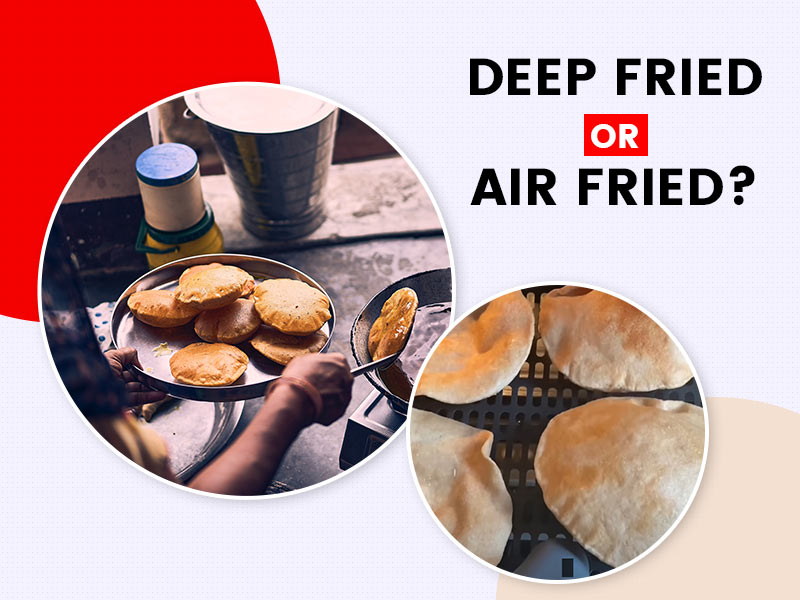
Diwali is just around the corner. On this occasion, family and friends get together, and have a gala time. Food during Diwali is a celebration in itself. However, at a time when a person is trying to lose weight and get fit, one needs to pay attention to what he/she eats. During Diwali, people generally prepare a lot of fried foods. With the increasing focus on health and fitness, alternatives to deep frying are now available. One such alternative technique, which is believed to be healthier, is air-frying. However, is it really better than our age-old tradition of deep-frying? Let us see what celebrity nutritionist Rujuta Diwekar has to say about this.
Table of Content:-
But before that, let us understand the difference between the two techniques. First coming to deep-frying, in this you fry a food item by completely submerging it in fat, typically oil. On the other hand, air-frying uses little to no oil at all, and is touted as a healthier option when it comes to frying. This is done in an appliance called an air-fryer in which hot air circulates around the food giving it a crispy exterior structure.
Deep Frying Or Air Frying?

(Photo Credit: Unsplash)
In a video she posted on social media, celebrity nutritionist Rujuta Diwekar said that fried foods are a part of our traditional Diwali celebration and these should be made using the traditional oil of your choice, be it coconut, groundnut, sesame, etc. And, you should deep fry these by first heating the oil on a low flame and then frying the food item on the sim. Never reuse that oil, unless it is homemade ghee. Now coming to what technique is better. Deep-fried foods, according to Rujuta:
- Induces a sense of satiety
- You feel light and not acidic or bloated
- Your craving for sugar vanishes.
On the other hand, air-fried foods:
- Do not make you satisfied, which means in place of having one or two samosas, you might go for three, four or even five. This is further exacerbated by the false sense of security that air-fried foods are low in calories.
- You feel acidic or bloated, instead of feeling light in the stomach.
- You start craving sugar, which you ultimately satisfy with either cola, or a dessert, which further adds on the calories.
Hence, these points clearly hint at Rujuta’s preference for deep-fried foods over air-fried ones.
Also read: Weight Loss Thali: 10 Expert Tips To Lose Weight Without Dieting
Rujuta Diwekar’s Diwali Tips
In the video, the nutritionist shared some tips that might help people stay happy and healthy this Diwali:
View this post on Instagram
- First and foremost, if you think your diet will go for a toss this Diwali, then you are not on a sustainable diet. Also, the aim of the diet should not be to help you lose weight quickly, but to keep your weight off throughout life and to keep you healthy, energetic and happy.
- Also, many think that keeping up till late during the festival might make them fat. If you also think the same then remember a night might not make as much of a difference as what you do throughout the year. Hence, have a proper sleep schedule throughout the year.
- Do not starve yourself in anticipation of the Diwali night, so that you could indulge in all the foods. Just eat normally.
If you are going out on Diwali night or the nights around the day, then:
- Eat a banana or some curd and rice before going out. This will prevent bloating, acidity and irritation the next morning.
- Choose to eat two starters at the most.
- If you are going to a restaurant or there is a buffet, you might have several cuisines to choose from. However, just pick one of them, and have at most three items of that cuisine.
- Regarding sweets, pick the one that is Diwali-specific and avoid those that are available all year round. If you are at someone’s home, have the sweet that he/she has prepared at home.
Also read: Diwali 2021: Easy And Healthy Hacks To Celebrate Diwali
And when you come back home, massage your feet with some ghee, have some warm water, avoid spending time on your phone and have a good night’s sleep. These will ensure you have a healthy and happy Diwali.
Photo Credit: Unsplash; YouTube Screengrab/Chillipot Kitchen
Also watch this video
How we keep this article up to date:
We work with experts and keep a close eye on the latest in health and wellness. Whenever there is a new research or helpful information, we update our articles with accurate and useful advice.
Current Version